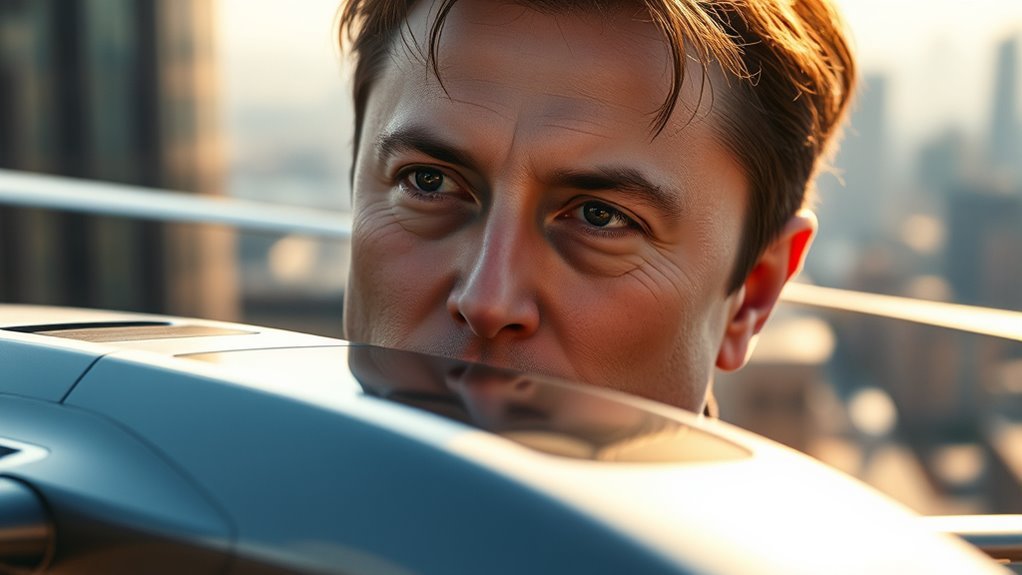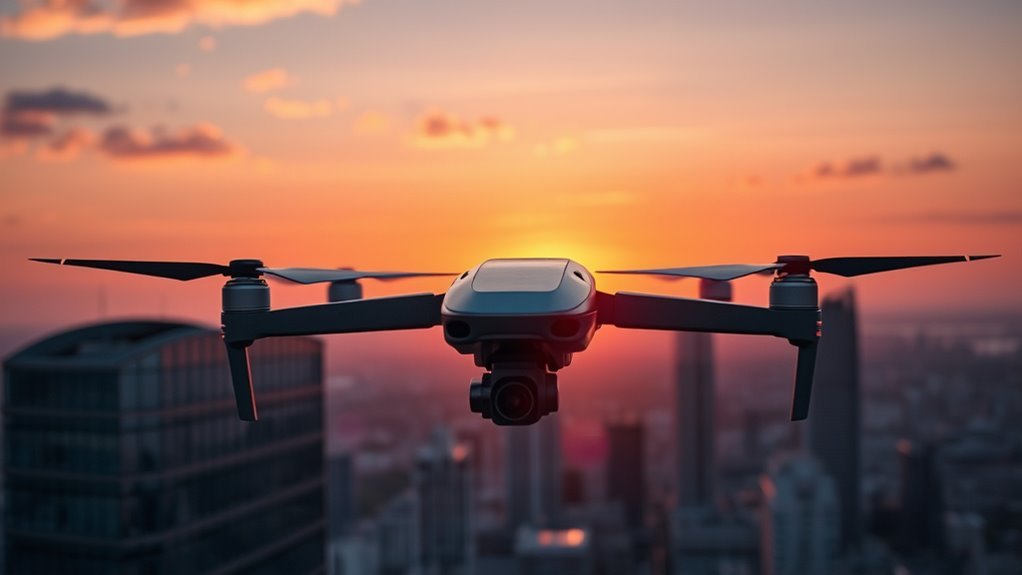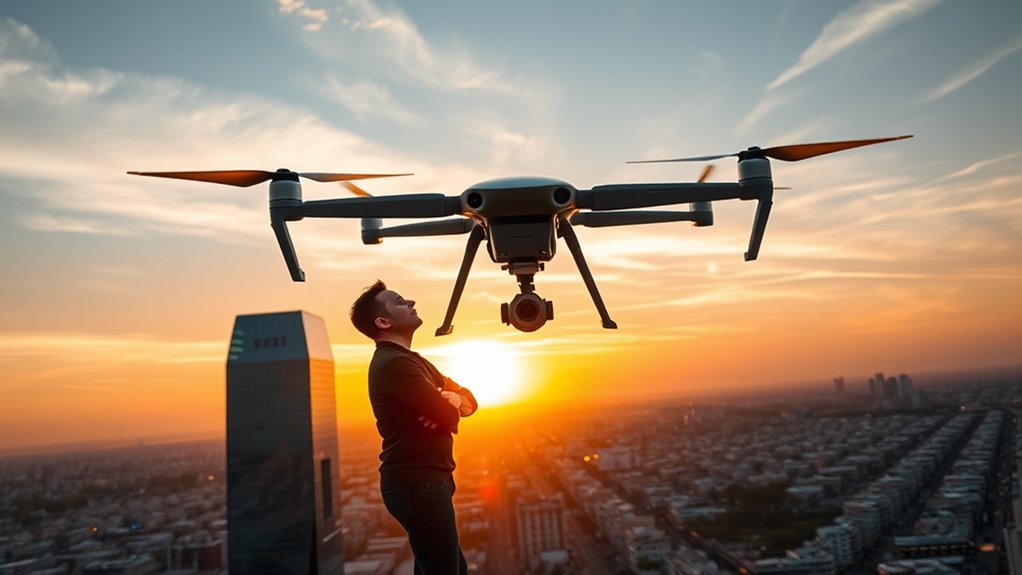Elon Musk views drones as game changers in transportation and urban mobility, emphasizing their speed and efficiency in package deliveries. They cut costs and reduce traffic congestion, making logistics more agile. Drones also play crucial roles in emergency response and agriculture, offering rapid support and insights into crop health. With AI integration, drones enhance safety and operational efficiency. There’s much more to uncover about Musk’s predictions and the evolving role of drones in various industries.
Drones as a Game Changer for Transportation

As cities grow and traffic congestion worsens, it’s clear that traditional transportation methods can’t keep up with the demands of modern life. Enter drones as a game changer for transportation. With advancements in drone logistics, you can imagine a future where aerial mobility revolutionizes how goods and people move. These flying machines aren’t just a novelty; they provide a swift alternative to ground transport, reducing delays and lowering the carbon footprint. You could receive packages in minutes rather than days, freeing you from the constraints of congested roads. Additionally, drones can access hard-to-reach areas, ensuring that essential services are delivered efficiently. Drones enhance access to healthcare by shortening delivery times to remote locations, fostering resilience in public health. Embracing this technology means embracing a new era of freedom in transportation, where the skies become your gateway to convenience. The capability of drones to deliver payloads up to 10 kg significantly enhances their versatility in urban logistics.
The Role of Drones in Urban Mobility

Drones are poised to redefine urban mobility, addressing the increasing challenges of congestion and limited infrastructure in bustling cities. By utilizing urban airspace effectively, drones can provide quick, efficient transport options, reducing the strain on traditional ground-based systems. Additionally, advanced AI integration in drone technology can enhance their operational efficiency and safety. Furthermore, real-time data analysis enables drones to adapt to dynamic urban environments, optimizing delivery routes and enhancing overall service efficiency.
| Benefit | Challenge | Solution |
|---|---|---|
| Reduced Congestion | Regulatory Hurdles | Develop drone infrastructure |
| Increased Accessibility | Safety Concerns | Implement strict guidelines |
| Cost-Effective Transport | Public Acceptance | Raise awareness of benefits |
As cities embrace drone technology, you’ll witness a transformation in how you navigate urban environments. This innovation not only promotes freedom of movement but also paves the way for a more sustainable future. The potential’s immense; it’s time to imagine the possibilities.
Enhancing Delivery Services With Drone Technology

Imagine a world where your packages arrive at your doorstep in minutes rather than days. With drone technology, not only can you expect speedy transportation, but businesses can also considerably cut logistics costs. This innovative approach is reshaping how we think about delivery services and their efficiency. Additionally, the MK30 drone’s AI-powered navigation system enhances delivery precision and safety, allowing for reliable and damage-free deliveries. The MK30’s compact aerodynamics enable it to navigate urban environments with ease, further improving delivery speed and efficiency.
Speedy Package Transportation
While many industries are racing to adopt cutting-edge technologies, the logistics sector stands to gain immensely from drone integration. Drone delivery isn’t just a futuristic concept; it’s reshaping how you receive your packages. With enhanced speed and efficiency, drones can transform the landscape of delivery services. Here are four ways drones improve package transportation:
- Rapid Delivery: Drones can cover significant distances in a fraction of the time.
- Real-Time Package Tracking: You can monitor your delivery’s progress with precision.
- Reduced Traffic Congestion: Drones bypass road delays, ensuring timely arrivals.
- Access to Remote Areas: They can reach locations traditional vehicles can’t easily access.
Embracing this technology gives you the freedom to expect faster, more reliable deliveries.
Cost-Effective Logistics Solutions
As the logistics sector embraces rapid delivery methods, another notable advantage of drone technology emerges: cost-effectiveness. You can imagine a future where automated deliveries cut down on labor costs and streamline operations. With drones taking to the skies, businesses can minimize transportation expenses considerably, ensuring that you receive your packages faster and cheaper.
Integrating drone warehousing into the logistics chain offers even more savings. By positioning drones at strategic locations, companies can reduce the need for extensive ground transportation, which not only saves money but also lessens environmental impact. This innovative approach allows for agile supply chains that adapt to demand. Ultimately, embracing drone technology means revealing a new domain of possibilities for cost-effective logistics solutions, giving you more freedom in how you receive goods.
Drones in Emergency Response and Disaster Relief
Drones have emerged as invaluable tools in emergency response and disaster relief, especially when traditional methods face limitations. They offer innovative solutions that can greatly enhance efficiency and effectiveness. Here’s how:
- Emergency Medical Deliveries: Drones can quickly transport medical supplies, vaccines, and even blood to remote or disaster-stricken areas, saving critical time.
- Real-time Surveillance: They provide aerial views of affected regions, enabling better assessment of damage and resource allocation.
- Search and Rescue Operations: Drones can locate missing persons in hard-to-reach areas, increasing survival chances.
- Disaster Logistics Coordination: They assist in managing relief supplies, ensuring timely distribution to those in need.
The Future of Agricultural Drones
With advancements in technology accelerating at an unprecedented pace, the future of agricultural drones looks promising and transformative. Imagine using drones for crop monitoring and pest management, empowering farmers to make informed decisions. Through precision farming techniques, you can achieve yield optimization while practicing sustainable methods. Drones facilitate soil analysis, enhancing resource efficiency by pinpointing areas that need attention. Additionally, drones’ advanced crop monitoring solutions enable farmers to capture high-resolution imagery, providing insights into plant health that were previously unattainable. With capabilities like crop spraying and weather prediction, these aerial devices can revolutionize agricultural processes. Additionally, data collection becomes seamless, allowing you to track growth and health metrics over time. As you embrace these innovations, the potential for increased productivity and environmental stewardship in farming is at your fingertips, paving the way for a more sustainable agricultural future. Delair’s multispectral cameras also play a crucial role in transforming crop health management through real-time data analysis.
Drones and Environmental Monitoring
While the impact of climate change becomes increasingly evident, the role of drones in environmental monitoring is proving to be invaluable. These flying devices can gather environmental data quickly and effectively, making them essential tools for addressing pollution and conserving our planet. Here are four key applications of drones in this field:
- Air Quality Assessment: Drones can measure pollutants in the atmosphere, providing real-time data.
- Wildlife Tracking: They monitor animal populations, helping to protect endangered species.
- Forest Health Monitoring: Drones assess vegetation and detect diseases or pests.
- Disaster Response: They survey areas affected by natural disasters, aiding recovery efforts.
The Impact of Drones on Manufacturing
Drones are revolutionizing manufacturing by streamlining production processes and enhancing efficiency. You’ll find that their precision in assembly reduces errors and increases overall quality, leading to significant cost savings. Furthermore, drones optimize supply chains, ensuring materials are delivered swiftly and accurately, which can transform operational capabilities.
Enhanced Production Efficiency
In today’s fast-paced manufacturing landscape, a significant shift towards enhanced production efficiency is evident, largely driven by the integration of drone technology. You’ll find that drones not only streamline operations but also facilitate automated workflows, leading to substantial productivity enhancements. Here are four key benefits of using drones in manufacturing:
- Real-time monitoring: Drones can oversee production lines, identifying bottlenecks instantly.
- Inventory management: They can perform stock checks and manage supplies more efficiently.
- Reduced labor costs: Automation through drones allows you to reallocate human resources to more critical tasks.
- Faster deliveries: Drones expedite transportation of materials across facilities, minimizing downtime.
As you embrace drone technology, you’ll access new levels of efficiency that can redefine your manufacturing processes.
Precision in Assembly
As manufacturers seek to optimize their assembly processes, the role of drone technology becomes increasingly essential. Drones enhance robotic assembly by providing automated precision that traditional methods often lack. Imagine a world where drones effortlessly transport components, ensuring they’re placed exactly where they need to be with minimal human intervention. This level of accuracy not only reduces errors but also accelerates production timelines, allowing you to respond to market demands swiftly. Additionally, the integration of drones into assembly lines fosters a dynamic environment where creativity thrives, as workers can focus on innovation rather than repetitive tasks. Embracing drone technology isn’t just about efficiency; it’s about liberating your workforce to achieve greater heights in manufacturing excellence.
Supply Chain Optimization
The integration of drone technology into manufacturing not only revolutionizes assembly processes but also redefines supply chain optimization. By leveraging drone tracking and enhancing inventory management, you can achieve unprecedented efficiency. Here are four key benefits to evaluate:
- Real-time monitoring: Drones provide instant visibility into stock levels, ensuring you never face shortages.
- Faster deliveries: With drones, you can expedite transportation between warehouses, minimizing downtime.
- Reduced labor costs: Automating inventory checks can free up your workforce for more critical tasks.
- Enhanced data collection: Drones gather valuable insights on supply chain performance, allowing for informed decision-making.
Embracing drone technology means you’re not just keeping up with the competition; you’re setting the pace for the future of manufacturing.
Drones in the Entertainment Industry
While many people associate drones with delivery services or surveillance, their impact on the entertainment industry has been nothing short of revolutionary. Drones have transformed how filmmakers capture stunning visuals and choreograph aerial performances. With drone cinematography, you can achieve breathtaking shots that were once only possible with expensive helicopters. Notably, advanced algorithms control drone choreography to create synchronized performances that captivate audiences.
Here’s a quick look at their contributions:
| Aspect | Benefits | Examples |
|---|---|---|
| Drone Cinematography | Unique perspectives | Movies, commercials |
| Aerial Choreography | Dynamic performances | Concerts, events |
| Cost Efficiency | Reduces production costs | Independent films |
As you explore the world of entertainment, consider how drones can release creativity and elevate storytelling in ways you never imagined. Notably, companies like Lumina Aerial Displays are utilizing innovative technology to enhance visual storytelling through intricate aerial shows.
Regulatory Challenges for Drone Adoption
As you explore the landscape of drone adoption, you’ll quickly encounter various regulatory challenges that could shape its future. Airspace management, privacy concerns, and safety regulations are critical factors that must be addressed for widespread integration. Understanding these complexities is essential for maneuvering the evolving drone ecosystem effectively.
Airspace Management Issues
Maneuvering the complex landscape of airspace management is essential for the successful integration of drones into everyday air travel. To achieve this, you’ll need to take into account several key airspace integration strategies and effective drone traffic management methods:
- Standardized Regulations: Clear rules across regions can help streamline operations and reduce confusion.
- Real-Time Data Sharing: Utilizing technology to share airspace information can enhance safety and efficiency.
- Automated Traffic Control Systems: Implementing AI-driven systems can help manage drone traffic more effectively.
- Public Awareness Campaigns: Educating the public about drone operations can build trust and acceptance.
Privacy Concerns
The integration of drones into airspace management brings forth not only operational challenges but also significant privacy concerns that can hinder their widespread adoption. You might appreciate the freedom drones offer, yet surveillance concerns loom large. Many people worry about drones capturing personal data without consent, creating a landscape where privacy feels compromised. To address these issues, regulations around data protection must evolve, ensuring that drone operators are held accountable for their actions. Striking a balance between innovation and individual rights is essential. As you navigate this new frontier, understanding the implications of drone technology on privacy will empower you to advocate for responsible usage and robust safeguards, ultimately fostering a future where both freedom and privacy coexist harmoniously.
Safety Regulations
While the promise of drone technology continues to captivate industries and consumers alike, regulatory challenges regarding safety regulations pose significant hurdles to their widespread adoption. To navigate these issues, you need to understand key aspects of drone safety and regulatory compliance:
- Operational Limits: Drones must operate within designated airspace to minimize risks.
- Pilot Certification: Operators often need formal training or certification to guarantee safety standards.
- Maintenance Standards: Regular checks and maintenance are essential to avoid malfunctions.
- Public Awareness: Educating the public about drone operations can reduce accidents and enhance compliance.
The Potential of AI-Driven Drones
As the landscape of technology evolves, AI-driven drones are poised to revolutionize various industries by enhancing efficiency and decision-making capabilities. With advancements in AI integration and machine learning, these drones can autonomously navigate complex environments, ensuring optimal data collection and drone security. Imagine harnessing swarm technology, where multiple drones operate in harmony, sharing insights to improve predictive analytics. Furthermore, with advanced safety features like those in EHang’s systems, we can ensure that these drones effectively manage airspace constraints and minimize the risk of collisions. However, we must also consider the ethical implications of deploying such technologies. Balancing innovation with responsibility is essential, as these powerful tools could reshape logistics, agriculture, and surveillance. By embracing AI-driven drones, you open doors to unprecedented freedom in operations, but it’s imperative to navigate the potential risks and benefits wisely. The future’s bright, but it’s up to you to steer it responsibly. Furthermore, with AI-enhanced obstacle avoidance features, drones can significantly improve flight safety by detecting and avoiding potential hazards in real time.
Frequently Asked Questions
What Specific Drone Technologies Does Elon Musk Find Most Promising?
When considering promising drone technologies, you’ll find that autonomous navigation and advanced delivery systems stand out. These innovations could revolutionize logistics and personal freedom, enabling faster, more efficient, and accessible solutions for everyone.
How Does Elon Musk Envision Drones Affecting Job Markets?
You might see drones as catalysts for workforce transformation, subtly reshaping job markets. While they could lead to job displacement, they also create new opportunities, enhancing freedom and innovation in various industries, paving paths for growth.
What Ethical Considerations Does Elon Musk Associate With Drone Usage?
When considering drone usage, you can’t ignore the ethical concerns. Drone surveillance raises significant privacy implications, as it blurs the line between security and personal freedom, prompting debates on how to balance these competing interests responsibly.
How Does Elon Musk Address Public Safety Concerns Regarding Drones?
When addressing public safety concerns, you’ll find Musk juxtaposes public perception with regulatory frameworks. He emphasizes balancing innovation and safety, advocating for regulations that empower freedom while ensuring drones operate responsibly within societal norms.
What Future Innovations in Drones Does Elon Musk Predict?
You might see drones evolving into tools for autonomous deliveries and advanced aerial surveillance. These innovations could enhance efficiency and security, reshaping industries while giving you greater freedom and convenience in your daily life.

